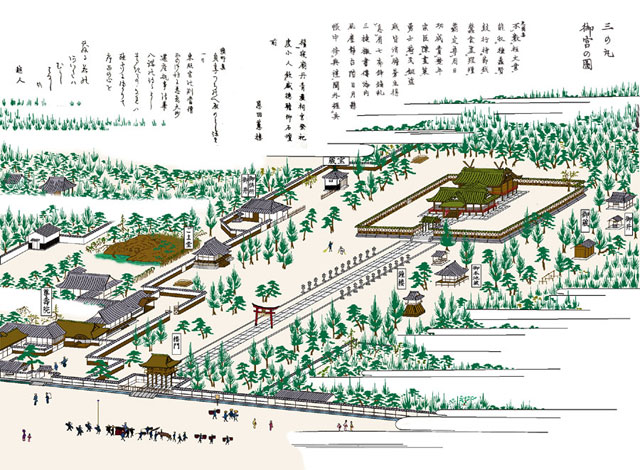Nagoya Tōshō-gū on:
[Wikipedia]
[Google]
[Amazon]
is a Shinto shrine located in central

Homepage of Nagoya Tōshō-gū
Shinto shrines in Nagoya Nagoya Castle Buildings and structures in Japan destroyed during World War II Religious buildings and structures completed in 1651 Tōshō-gū {{shinto-stub
Nagoya
is the largest city in the Chūbu region, the fourth-most populous city and third most populous urban area in Japan, with a population of 2.3million in 2020. Located on the Pacific coast in central Honshu, it is the capital and the most po ...
, Aichi Prefecture, Japan.
History

Tōshō-gū
is any Shinto shrine in which Tokugawa Ieyasu (1543–1616) is enshrined.
Ieyasu was the founder of the Tokugawa shogunate (1603-1868), which is the third and last of the shogunal governments in Japanese history. He was deified with the name , ...
is dedicated to Tokugawa Ieyasu
was the founder and first ''shōgun'' of the Tokugawa Shogunate of Japan, which ruled Japan from 1603 until the Meiji Restoration in 1868. He was one of the three "Great Unifiers" of Japan, along with his former lord Oda Nobunaga and fello ...
, the founder of the Tokugawa shogunate
The Tokugawa shogunate (, Japanese 徳川幕府 ''Tokugawa bakufu''), also known as the , was the military government of Japan during the Edo period from 1603 to 1868. Nussbaum, Louis-Frédéric. (2005)"''Tokugawa-jidai''"in ''Japan Encyclopedia ...
. It was built in 1619 (Genna 5) on the orders of Lord Tokugawa Yoshinao
was a Japanese ''daimyō'' of the early Edo period.
Biography
Born the ninth son of Tokugawa Ieyasu with his concubine, Okame no Kata. His childhood name was Gorōtamaru (五郎太丸). While still a young child, he was appointed leader of ...
of Owari, two years after the construction of Nikkō Tōshō-gū
is a Tōshō-gū Shinto shrine located in Nikkō, Tochigi Prefecture, Japan.
Together with Futarasan Shrine and Rinnō-ji, it forms the Shrines and Temples of Nikkō UNESCO World Heritage Site, with 42 structures of the shrine included in t ...
. It was located outside Nagoya Castle in the Sannomaru enceinte, next to the ''Tennosha'' (today's Nagoya Shrine).
The Nagoya Tōshō-gū Festival was the biggest festival in Nagoya before the Second World War.
The shrine was moved from the Sannomaru enceinte of Nagoya Castle to its present location in the late 19th century. The original main hall burned during the air raids of the Pacific War. The present main hall was a mausoleum for Lord Yoshinao's consort Haruhime (春姫), which used to be located at Kenchū-ji
Kenchū-ji (建中寺) is a Jōdo-shū Buddhist temple in Tsutsui, Higashi-ku, Nagoya, central Japan. Starting in the Edo period, the mausoleums of the lords of the Owari Domain were located there, making it the '' Bodaiji'' of the Owari Tokuga ...
temple, and was moved to the site in 1953 as a replacement. It is a designated cultural property of Aichi prefecture.
A model of the old shrine's main hall is kept at the Engineering Faculty of Tokyo University.
References
External links
Homepage of Nagoya Tōshō-gū
Shinto shrines in Nagoya Nagoya Castle Buildings and structures in Japan destroyed during World War II Religious buildings and structures completed in 1651 Tōshō-gū {{shinto-stub